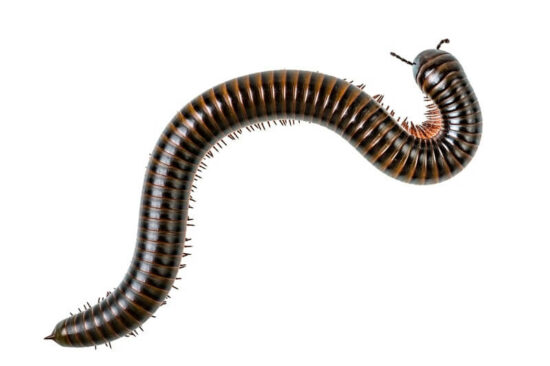Because of their spooky appearance, many homeowners want to learn how to get rid of millipedes quickly.
But how do you do this?
This guide will teach you how to get rid of millipedes in your house, keep them away, and look out for them in the future.
Table of Contents
Why Do Millipedes End Up In Your Home?
If ever there was a misunderstood creature, it would be the millipede. With its worm-like body, stumpy antennae and seemingly thousands of legs, this tiny arthropod does not have many admirers. Does it have a thousand legs as its name implies? The average millipede has between 80 and 400 legs, so its name, which means “thousand legs” is a bit of an exaggeration.
Despite its looks, the millipede is a pretty harmless creature. However, most people are repulsed by its appearance, and they see millipedes as something dangerous that they need to get rid of.
With all of these misconceptions, it’s no wonder that so many homeowners freak out when they discover a millipede in their living space. Having millipedes in your home is not as common an occurrence as having ants or roaches, but it does happen.
Why do millipedes end up in your home? There are a couple of reasons.
The first reason is that they are looking for shelter from outdoor conditions. Unlike other home invaders, millipedes aren’t after fallen crumbs or food from your pantry; they are just searching for a place to get away from too much rain, sun or dry weather.
Another reason that you may find a millipede in your home is that it’s seeking a source of moisture. Millipedes love it wherever it’s damp and moist, so if they can’t find these conditions outside, they are going to try the inside of your home.
Maybe the most common reason for millipedes to be inside your house is they simply get in by mistake. They either crawl in under the door or through cracks in your foundation, they can come in from your garage or basement, and they will sometimes get in through pipes and air conditioning units. Millipedes can fit into very tiny spaces, so any little crack or hole will allow them to get in.
How To Get Rid Of Millipedes
Even though millipedes don’t pose any real threat to people, pets, or your food, they are still not welcome visitors in most homes.
So how can you get rid of millipedes if you find them in your house? There are several do-it-yourself methods you can try that will help, so let’s take a look at how you should approach this.
Remove The Ones You See
One of the easiest ways to get rid of millipedes in your house is to simply remove any that you find. They don’t bite, and they don’t scurry around like a cockroach, so it’s very easy to just sweep them up with a broom or pick them up and remove them. These aren’t a pest that will quickly multiply into thousands, so getting rid of them one-at-a-time is actually rather effective
While millipedes are not poisonous, they do exude a foul smelling liquid if you squish them. This liquid is known to cause blisters on the skin, so use gloves when handling millipedes.
If you don’t want to pick them up and manually remove them, then you can sweep them up with a broom. You can either toss them back outside, or you can drop them into soapy water to kill them. Just be very careful not to squash them in any way, so you don’t stimulate the response that causes them to give off the bad smelling glandular liquid.
Expert Tip: It’s not always a good idea to use a vacuum cleaner for millipedes until they are dead. The reason for this is that if you vacuum up millipedes while they are still alive, they may release their terrible smell, and you will have a hard time getting that odor out of your vacuum cleaner.
Be Patient
Millipedes are totally harmless, so if you’re squeamish about getting rid of them, then you can just let them be. Without the moisture that they need to survive, they will die and dry up in a day or so.
Once they are dead, they are easy to sweep up or suck up with a vacuum. We know that you probably want to get rid of millipedes in your home as soon as possible, but leaving them alone to die on their own will not cause any harm to your home, family members or your pets.
How To Keep Millipedes Away
There’s not much that needs to be done if you find a millipede or two in your house. Your real focus should be taking the appropriate actions to prevent them from getting in at all. Depending on your situation, solutions range from chemical treatments and traps to more natural alternatives. How you choose to handle things pretty much depends on your situation and needs.
If you’ve gotten rid of the millipedes in your house and want to make sure they don’t come back, you have some options. Let’s run through a few of the more common methods, and then you can choose the one that sounds right for you. It’s perfectly fine to use more than one!
Clean Up Your Yard
Like we mentioned before, millipedes usually end up inside your home by accident, or they come in because they are seeking shelter or moisture. To be quite honest, millipedes are more than happy to stay hunkered down in the leaf litter, mulch, wood piles and moist soil around your home. They are pretty shy and prefer it where it’s dark and quiet.
If you have a garden, compost pile, piles of wood or mulch in your garden, then you most likely have millipedes. They’re actually great for your yard because they eat decaying wood, rotting plant matter, other bugs and the bodies of dead animals.
However, to keep them outside and not in your house, you’ll need to do a bit of yard work. It’s fine to have a compost pile, mulch in your plant beds or even a woodpile. What you don’t want is to have these things near the foundation of your home. Take the time to move millipede hot spots away from your foundation, so you won’t have to worry about getting rid of millipedes in your house.
Time To Make Repairs
In addition to cleaning up your yard, it’s a good idea to do an inspection of your home’s exterior. There are so many places where millipedes can sneak in, so making sure that you have repaired, caulked and fixed all possible entry points is going to be key.
What are some of the things that you should be looking for? Check downspouts and gutters for leaves, look for cracks or small openings in the foundation, make sure that you have a door sweep on all exterior doors, and check all windows for caulking.
Remember that millipedes can crawl through even the tiniest of spaces, so think like a millipede and make a careful inspection. When it comes to blocking entry points, it’s better to err on the side of caution.
Create A Barrier
Any millipedes that you’re forced to get rid of are usually in your house by accident. Millipedes will also come into homes looking for shelter or a source of moisture. It can often be helpful to create some type of a barrier that either keeps millipedes from trying to get in, or it will prove deadly if they try. There are all-natural barriers as well as various poisons that can be used as effective barriers.
The method that you choose depends on whether your goal is to repel the millipedes or kill them. If you are just trying to repel the millipedes, then you may want to try creating a barrier from essential oil or cayenne powder.
For an essential oil treatment, make a solution from tea tree oil or peppermint oil and some water. Put the solution into a spray bottle and spray your foundation, door gaps and other entry points. If you’re using cayenne powder, sprinkle it in the same areas we just mentioned.
To create a barrier that’s designed to actually kill millipedes instead of keeping them away, you can try sprinkling either diatomaceous earth or boric acid around the entry points. Both diatomaceous earth and boric acid cause death through dehydration.
Set A Trap
There are various traps that are designed to catch millipedes, and they can be found in retail and home improvement stores. The most common kinds are glue traps, light traps and homemade traps.
Use An Insecticide
Many people don’t want to fiddle around with do-it-yourself techniques and would rather use some kind of insecticide. There are sprays, powders and granules that can be used as a barrier around your home. Granular insecticide is mostly made to be spread on your lawn, but it can be sprinkled around the foundation of your house as well.
The one advantage of using an insecticide is that it will kill both millipedes and other insects. However, spraying an insecticide may not be the best option if you have kids or pets
Call A Pest Control Company
In most cases, millipedes never really become a problem that’s serious enough to call in outside help. However, there are times that you may think that too many are finding their way into your home. If this is the case, and you’ve tried other methods, then calling in a professional may be a good idea.
Are They Dangerous?
You might want to get rid of millipedes because they look scary, but they are actually quite harmless. They don’t bite, they are not poisonous, and they don’t damage your home. The only really negative issue is that they exude a noxious fluid that not only smells quite bad, but it can even burn your skin and cause blisters.
Not only are millipedes pretty harmless to humans, they are not poisonous to pets either. That being said, it’s better if your pet doesn’t eat one because they could get slightly sick from the glandular fluid given off by millipedes. Even then, your pets will most likely not suffer anything more than a very upset stomach.
Millipedes are often mistaken for centipedes. Whereas millipedes don’t bite, centipedes may. Centipede bites can be quite painful and may cause swelling, redness, nausea and vomiting. Because many people know that centipedes bite, they may understandably assume that millipedes do as well.
Wrapping Up
Now that you know how to get rid of millipedes (and a little more about these critters in general), it’s up to you to decide if you think it’s necessary or not. While bizarre-looking, these animals are rather harmless and rarely multiply to a point that’s hard to deal with.
For many, simply taking them outside will be enough. But if you’re looking for more extreme methods in the future, refer to this guide!


